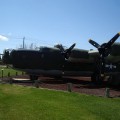
Myasiščev M-4 Bizon | |
|---|---|
| Země | Sovětský svaz |
| Typ | Strategický bombardér |
| První let | 20. ledna 1953 |
| Postaven | 91+2 |
Fotogalerie M-4 Bizoni, The Myasishchev M-4 Molot (Russian: Молот (Hammer), USAF/DoD reporting name “Type 37”, NATO reporting name Bison) is a four-engined strategic bomber designed by Vladimir Myasishchev and manufactured by the Soviet Union in the 1950s to provide a Long Range Aviation bomber capable of attacking targets in North America. The Myasishchev design bureau was formed to build such a bomber.
Zdroj: M-4 Bizon na Wiki
| Myasishchev M-4 Bison | |
|---|---|
| Fotograf | Unknow |
| Lokalizace | Boris Vasiljev |
| Fotografie | 13 |
| M-4 Bizon procházka kolem | |
|---|---|
| Fotograf | Sergej Tsvetkov |
| Lokalizace | Letecká základna Dyagilevo, Rjazaň, Rusko |
| Fotografie | 19 |
Související sady:
| Myasischev M-4 Walk Around | |
|---|---|
| Fotograf | Unknow |
| Lokalizace | Jevgenij Malinovskij |
| Fotografie | 31 |
Najděte sady na eBay:
Mjasiščev M-4 Bison byl sovětský strategický bombardér navržený Vladimirem Mjasiščevem v roce 1950. Byl to první sovětský bombardér schopný dopravit jaderné zbraně na cíle v kontinentálních Spojených státech. M-4 měl konstrukci se šípovým křídlem se čtyřmi proudovými motory namontovanými na pylonech pod křídly. Měl osmičlennou posádku a mohl nést až 24 000 kg bomb nebo raket.
M-4 vstoupil do služby v roce 1956 a zpočátku byl nasazen v bombardovacích plucích podél sovětských hranic. Brzy se však ukázalo, že M-4 má omezený dolet a užitečné zatížení ve srovnání se svými americkými protějšky, jako je B-52 Stratofortress. M-4 byl také zranitelný vůči zachycení stíhačkami a raketami země-vzduch. V důsledku toho byl M-4 postupně nahrazován pokročilejšími bombardéry, jako jsou Tupolev Tu-95 Bear a Tupolev Tu-16 Badger. M-4 byl vyřazen ze služby v roce 1994 a dnes se v muzeích dochovalo jen několik exemplářů.

Počet zobrazení: 1922









